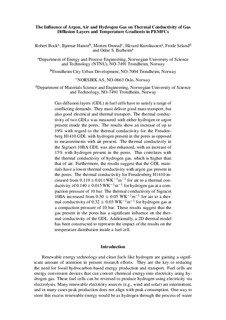| dc.contributor.author | Bock, Robert | |
| dc.contributor.author | Hamre, Bjørnar | |
| dc.contributor.author | Onsrud, Morten Andreas | |
| dc.contributor.author | Karoliussen, Håvard | |
| dc.contributor.author | Seland, Frode | |
| dc.contributor.author | Burheim, Odne Stokke | |
| dc.date.accessioned | 2020-02-05T10:08:12Z | |
| dc.date.available | 2020-02-05T10:08:12Z | |
| dc.date.created | 2020-01-20T11:35:10Z | |
| dc.date.issued | 2019 | |
| dc.identifier.citation | ECS Transactions. 2019, 92 (8), 223-245. | nb_NO |
| dc.identifier.issn | 1938-5862 | |
| dc.identifier.uri | http://hdl.handle.net/11250/2639755 | |
| dc.description.abstract | Gas diffusion layers (GDL) in fuel cells have to satisfy a range of conflicting demands. They must deliver good mass transport, but also good electrical and thermal transport. The thermal conductivity of two GDLs was measured with either hydrogen or argon present inside the pores. The results show an increase of up to 19% with regard to the thermal conductivity for the Freudenberg H1410 GDL with hydrogen present in the pores as opposed to measurements with air present. The thermal conductivity in the Sigracet 10BA GDL was also enhanced, with an increase of 15% with hydrogen present in the pores. This correlates with the thermal conductivity of hydrogen gas, which is higher than that of air. Furthermore, the results suggest that the GDL materials have a lower thermal conductivity with argon gas present in the pores. The thermal conductivity for Freudenberg H1410 increased from 0.119±0.011 WK-1m-1 for air to a thermal conductivity of 0.140±0.015 WK-1m-1 for hydrogen gas at a compaction pressure of 10 bar. The thermal conductivity of Sigracet 10BA increased from 0.30±0.05 WK-1m-1 for air to a thermal conductivity of 0.32±0.03 WK-1m-1 for hydrogen gas at a compaction pressure of 10 bar. These results suggest that the gas present in the pores has an influence on the thermal conductivity of the GDL. Additionally, a 2D thermal model has been constructed to represent the impact of the results on the temperature distribution inside a fuel cell. | nb_NO |
| dc.language.iso | eng | nb_NO |
| dc.publisher | Electrochemical Society | nb_NO |
| dc.title | The influence of argon, air and hydrogen gas on thermal conductivity of gas diffusion layers and temperature gradients in PEMFCs | nb_NO |
| dc.type | Journal article | nb_NO |
| dc.type | Peer reviewed | nb_NO |
| dc.description.version | acceptedVersion | nb_NO |
| dc.source.pagenumber | 223-245 | nb_NO |
| dc.source.volume | 92 | nb_NO |
| dc.source.journal | ECS Transactions | nb_NO |
| dc.source.issue | 8 | nb_NO |
| dc.identifier.doi | 10.1149/09208.0223ecst | |
| dc.identifier.cristin | 1777481 | |
| dc.description.localcode | This is an author-created, un-copyedited version of an article accepted for publication/published in [ECS Transactions]. IOP Publishing Ltd is not responsible for any errors or omissions in this version of the manuscript or any version derived from it. The Version of Record is available online at http://dx.doi.org/10.1149/09208.0223ecst | nb_NO |
| cristin.unitcode | 194,64,25,0 | |
| cristin.unitcode | 194,66,35,0 | |
| cristin.unitname | Institutt for energi- og prosessteknikk | |
| cristin.unitname | Institutt for materialteknologi | |
| cristin.ispublished | true | |
| cristin.fulltext | postprint | |
| cristin.qualitycode | 1 | |
